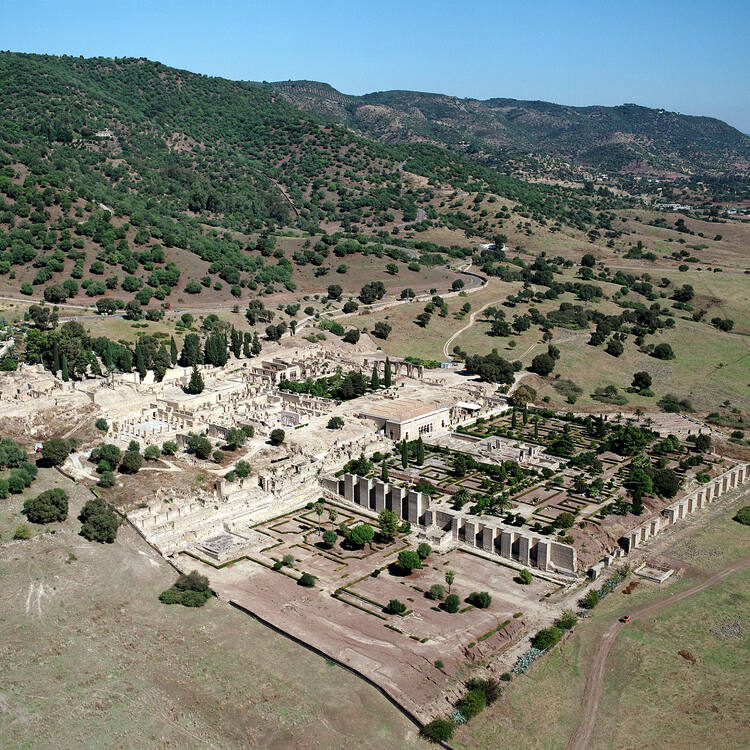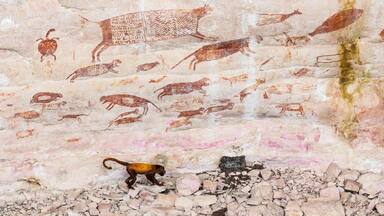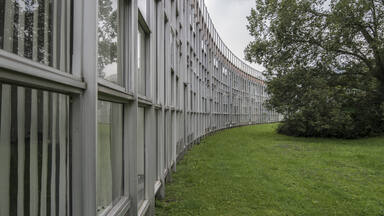Caliphate City of Medina Azahara
Caliphate City of Medina Azahara
The Caliphate city of Medina Azahara is an archaeological site of a city built in the mid-10th century CE by the Umayyad dynasty as the seat of the Caliphate of Cordoba. After prospering for several years, it was laid to waste during the civil war that put an end to the Caliphate in 1009-1010. The remains of the city were forgotten for almost 1,000 years until their rediscovery in the early 20th century. This complete urban ensemble features infrastructure such as roads, bridges, water systems, buildings, decorative elements and everyday objects. It provides in-depth knowledge of the now vanished Western Islamic civilization of Al-Andalus, at the height of its splendour.
Description is available under license CC-BY-SA IGO 3.0
Ville califale de Medina Azahara
La ville califale de Medina Azahara est un site archéologique d’une ville édifiée au milieu du Xe siècle de notre ère par la dynastie des Omeyyades comme siège du califat de Cordoue. Après avoir prospéré quelques années, elle fut mise à sac durant la guerre civile qui mit fin au califat en 1009-1010. Les vestiges furent oubliés pendant près de 1 000 ans, jusqu’à leur découverte au début du XXe siècle. Cet ensemble urbain complet comprend des infrastructures telles que des routes, ponts ou systèmes hydrauliques, des bâtiments, des éléments de décoration et des objets du quotidien. Il apporte une connaissance approfondie de la civilisation islamique occidentale d’Al-Andalus, aujourd’hui disparue, au sommet de sa splendeur.
Description is available under license CC-BY-SA IGO 3.0
مدينة الزهراء التي تعود لزمن الخلافة
تعدّ مدينة الزهراء التي تعود لزمن الخلافة موقعاً أثريّاً لمدينة كانت قد شيّدت في منتصف القرن العاشر على يد الأمويين لتكون مقرّاً لخليفة قرطبة. وبعد الازدهار الذي شهدته المدينة عدة سنوات، فقد تعرضت للنهب خلال الحرب الأهلية التي أنهت حكم الخليفة في عام 1009-1010. وقد بقيت هذه الآثار في طيات النسيان طوال ما يقرب 1000 عام لتعود للنور من جديد في بداية القرن
العشرين. وتضم هذه المنطقة الحضرية المتكاملة بنى أساسية مثل الشوارع والجسور والشبكات المائية والمباني وعناصر الزينة والأغراض المستخدمة في الحياة اليومية. وتقدّم المدينة معارف جمّة عن الحضارة الإسلامية الغربية المندثرة في الأندلس عندما كانت في أوج مجدها.
source: UNESCO/CPE
Description is available under license CC-BY-SA IGO 3.0
哈里发的阿尔扎哈拉古城
该遗产地是一个城市考古遗址,由倭马亚王朝建于公元10世纪中叶,是科尔多瓦哈里发的所在地。经过数年繁荣后,1009-1010年的内战期间摧毁了哈里发国家,也导致了城市的废弃。其遗迹被遗忘了近千年,直到20世纪初被重新发现。这个完整的城市综合体拥有道路、桥梁、水务系统、各类建筑、装饰元素和日用基础设施等。此遗产地展示了现已消失的安达卢斯西方伊斯兰文明在其鼎盛时期的风貌。
source: UNESCO/CPE
Description is available under license CC-BY-SA IGO 3.0
Дворцовый город Мадина Аз-захра
Дворцовый город Мадина Аз-захра, построенный в середине X века династией Омейядов и служивший столицей Кордовского халифата, является местом археологических раскопок. После нескольких лет процветания город был разграблен во время гражданской войны 1009-1010 гг., положившей конец существованию халифата. Руины города были забыты почти на тысячу лет, до момента их обнаружения в начале XX века. Этот совершенный городской ансамбль включает такие элементы инфраструктуры, как дороги, мосты и гидравлические системы, здания, а также сохраняет декоративные элементы и предметы быта. Дворцовый город Мадина Аз-захра дает более глубокое понимание ныне исчезнувшей западной исламской цивилизации Аль-Андалуса на пике её великолепия.
source: UNESCO/CPE
Description is available under license CC-BY-SA IGO 3.0
Ciudad califal de Medina Azahara
Este yacimiento arqueológico engloba los majestuosos vestigios de la ciudad palaciega edificada a mediados del siglo X por la dinastía de los Omeyas para que fuera sede del califato de Córdoba. Después de un próspero periodo de casi ochenta años, Medina Azahara fue saqueada durante la guerra civil sucesoria de 1009-1010 que acabó con el poder de los califas. Los restos de la ciudad cayeron en el olvido durante más mil años, hasta su redescubrimiento en el primer tercio del siglo XX. Este sitio urbano abarca numerosas infraestructuras —calzadas, puentes y sistemas hidráulicos— así como edificios, elementos decorativos y objetos de uso diario que permiten conocer más a fondo la época de máximo esplendor de la desaparecida civilización islámica occidental de al-Ándalus.
source: UNESCO/CPE
Description is available under license CC-BY-SA IGO 3.0
Outstanding Universal Value
Brief synthesis
The Caliphate City of Medina Azahara is an archaeological site of a newly-founded city built in the mid-10th century CE by the western Umayyad dynasty as the seat of the Caliphate of Cordoba. The city was destroyed shortly afterwards, and from that time remained hidden until its rediscovery in the early 20th century CE.
The site is a complete urban complex including infrastructure, buildings, decoration and objects of daily use, and provides in-depth knowledge about the material culture of the Islamic civilization of Al-Andalus at the zenith of its splendour but which has now disappeared. In addition, the landscape features which influenced the city’s location are conserved.
The hidden character of the site over a long period has contributed to its preservation and it has not been rebuilt or altered in that time. The rediscovery has led to excavation, protection and conservation which has continued for a century, promoted by public institutions.
Criterion (iii): The abandoned Caliphate City of Medina Azahara, being a new city planned and built as a state initiative, attests in an exceptional way to the Umayyad cultural and architectural civilization, and more generally to the development of the western Islamic civilization of Al-Andalus.
Criterion (iv): The Caliphate City of Medina Azahara is an outstanding example of urban planning combining architectural and landscape approaches, the technology of urban infrastructure, architecture, decoration and landscape adaptation, illustrating the significant period of the 10th century CE when the Umayyad caliphate of Cordoba was proclaimed in the Islamic West.
Integrity
The site includes the entire Caliphate city, and its buffer zone preserves the context of the city in its natural environment, as well as the remains of the main infrastructure of roads and canals that radiated from it. The quarries where the building material for the city was extracted and the major country villas (munya) have also survived in the buffer zone.
Because the city remained hidden from the time of its destruction in the early 11th century CE to its rediscovery in the early 20th century CE, and since the area was used for grazing livestock, the remains are very well preserved. Only 10% of the site has been excavated and the remainder offers an exceptional opportunity for future research. As for the excavated part of the Qasr or fortified palace, continued excavation and conservation work has brought to light a set of well conserved buildings whose original walls reach a height of several meters.
Authenticity
The site meets the conditions of authenticity in relation to materials, design and location. As regards the authenticity of the materials, as noted most of the site has remained unchanged and hidden below ground. As for the excavated areas, the work of consolidation, made necessary by the fragility of the materials, has been progressing under the philosophy of minimal intervention, in order to ensure the stability of structures, protect them against the elements and conserve the information produced during the excavation process.
This policy of minimal intervention has ensured that any new additions clearly differ from, but also blend in with, the original. Identifying the original position of the different materials used in building the city has made this work possible.
The authenticity of the site is also guaranteed by the conservation of its natural environment, where little has changed since the destruction of the city, except for a few small recent alterations. In addition, the descriptions of the buildings in a wide range of historical sources, the epigraphic evidence and the quality of research work carried out for over a century reinforce the authenticity of the site.
Protection and management requirements
The Caliphate City of Medina Azahara and its buffer zone have been protected almost continuously by the Administration since 1911, and the site has had its own management body since 1985. Accordingly, the site has a general framework of protection and management that guarantees the future maintenance of its Outstanding Universal Value.
Protection is assisted by the site being mostly in public ownership. The legal protection of Medina Azahara and its surroundings is also at the maximum level afforded by the Law of Spanish Historical Heritage, as a Property of Cultural Interest, under the category Archaeological Site.
The Special Plan for the Protection of Medina Azahara was approved in 1998, providing an urban planning law that regulated the boundaries of the protected area and established possible land uses for each defined category.
Various government and legal departments ensure strict compliance with this law, and thus avoid any potential threats.
The institutional framework for management is provided, since 1985, by a specific institution that manages the property and the buffer zone: the Archaeological Ensemble of Medina Azahara (CAMA). This institution has an organizational structure including areas of Administration, Conservation and Research/Publicity.
There are two planning instruments which have been developed and implemented to different degrees (the programmes of the Special Protection Plan and the Master Plan), which provide a solid basis for strategic guidelines to guarantee that Medina Azahara continues to be protected and appreciated.
The expected long-term results for management are to consolidate and increase human and budgetary resources for management, consolidating the public institution with its technical expertise as the main instrument for managing the site, providing it with greater functional autonomy and encouraging greater participation and coordination with other agencies and interested parties.
Another essential aim to ensure the preservation of the site is to update and have approved the Operational Plan for Medina Azahara.

